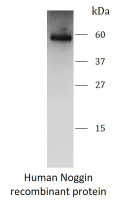ARG70475
Human Noggin recombinant protein (Active) (Fc-Tagged, C-ter)
Human Noggin recombinant protein (Active) (Fc-Tagged, C-ter) for SDS-PAGE
Overview
| Product Description | HEK293 expressed, Fc-Tagged (C-ter) Active Human Noggin recombinant protein |
|---|---|
| Tested Application | SDS-PAGE |
| Target Name | Noggin |
| Species | Human |
| A.A. Sequence | Gln28 - Cys232 |
| Expression System | HEK293 |
| Activity | Active |
| Activity Note | Measure by its ability to inhibit BMP-4-induced alkaline phosphatase production by ATDC5 cells. The ED50 for this effect is < 0.05 µg/mL in the presence of 50 ng/mL of recombinant human BMP-4. |
| Alternate Names | NOG; Noggin; Symphalangism 1 (Proximal); SYNS1; SYM1; Synostoses (Multiple) Syndrome; SYNS1A |
Properties
| Form | Powder |
|---|---|
| Purification Note | Endotoxin level is less than 0.1 EU/µg of the protein, as determined by the LAL test. |
| Purity | > 98% (by SDS-PAGE) |
| Buffer | PBS (pH 7.4) |
| Reconstitution | It is recommended to reconstitute the lyophilized protein in sterile water to a concentration not < 200 µg/ml and incubate the stock solution for at least 20 min at room temperature to make sure the protein is dissolved completely. |
| Storage Instruction | For long term, lyophilized protein should be stored at -20°C or -80°C. After reconstitution, aliquot and store at -20°C or -80°C for up to one month. Storage in frost free freezers is not recommended. Avoid repeated freeze/thaw cycles. Suggest spin the vial prior to opening. |
| Note | For laboratory research only, not for drug, diagnostic or other use. |
Bioinformation
| Gene Symbol | NOG |
|---|---|
| Gene Full Name | Noggin |
| Background | The secreted polypeptide, encoded by this gene, binds and inactivates members of the transforming growth factor-beta (TGF-beta) superfamily signaling proteins, such as bone morphogenetic protein-4 (BMP4). By diffusing through extracellular matrices more efficiently than members of the TGF-beta superfamily, this protein may have a principal role in creating morphogenic gradients. The protein appears to have pleiotropic effect, both early in development as well as in later stages. It was originally isolated from Xenopus based on its ability to restore normal dorsal-ventral body axis in embryos that had been artificially ventralized by UV treatment. The results of the mouse knockout of the ortholog suggest that it is involved in numerous developmental processes, such as neural tube fusion and joint formation. Recently, several dominant human NOG mutations in unrelated families with proximal symphalangism (SYM1) and multiple synostoses syndrome (SYNS1) were identified; both SYM1 and SYNS1 have multiple joint fusion as their principal feature, and map to the same region (17q22) as this gene. All of these mutations altered evolutionarily conserved amino acid residues. The amino acid sequence of this human gene is highly homologous to that of Xenopus, rat and mouse. [provided by RefSeq, Jul 2008] |
| Function | Inhibitor of bone morphogenetic proteins (BMP) signaling which is required for growth and patterning of the neural tube and somite. Essential for cartilage morphogenesis and joint formation. Inhibits chondrocyte differentiation through its interaction with GDF5 and, probably, GDF6 |
| Cellular Localization | Secreted |
Images (1) Click the Picture to Zoom In






